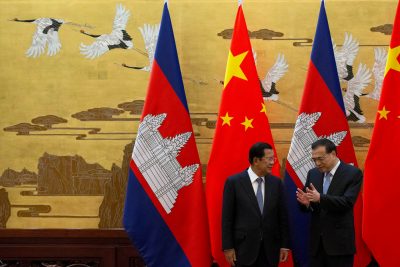China
Cambodia’s electric Chinese aid and investment affair

Author: Shahar Hameiri, University of Queensland
The debate about China’s rapidly growing global investment and development financing footprint has focused on deciphering Chinese intentions — whether China aims to revise or maintain the US-led ‘liberal international order’. A manifestation of this approach is the controversial ‘debt trap diplomacy’ trope — the idea that China is using its money to ensnare recipients in unequal relationships that secure Chinese geostrategic interests.
But the role of recipient governments in promoting large-scale Chinese projects and shaping their impact is often neglected.
Cambodia is a case in point. Observers often view Cambodia as China’s staunchest ally in Southeast Asia. Cambodia’s refusal, when ASEAN Chair in 2012, to release a communique criticising China’s conduct in the South China Sea was seen as evidence of this.
China is Cambodia’s biggest aid provider and Chinese investors hold almost a quarter of Cambodia’s total FDI stock. Distinguishing Chinese aid from investment is difficult, but there is no doubting China’s huge economic impact in Cambodia.
Yet the Cambodian government is often the driving force behind the biggest Chinese-financed projects. Keen to maintain the flow of economic opportunities to crony-capitalists whose support underpins the regime, Cambodian leader Hun Sen has reached out to China to finance controversial and sometimes financially unviable projects, especially in the hydropower sector.
The characteristics of China’s sprawling and fragmented development financing domain enable this. Chinese leaders often pledge headline-grabbing sums of money to particular countries or regions. In Cambodia’s case, US$500–700 million per annum was pledged in 2014. But disbursing the funds depends on project-by-project negotiations, typically between recipients and Chinese officials from local embassies and state-owned companies. China’s development financing is also generally ‘demand-driven’, so project ideas usually come from recipients — although state-owned enterprises often propose projects to recipients informally.
In Cambodia, the demand-driven system is shaped by patronage politics centred on Hun Sen and the Cambodian People’s Party. Unlike any other development partner, Chinese development financing is managed directly from the Prime Minister’s office, not via the Council for the Development of Cambodia, affording Hun Sen considerable scope to shape China’s development financing in Cambodia.
A prominent example is the Lower Se San 2 (LS2) dam. Construction of the dam displaced around 5,000 Cambodians. Tens of thousands more have been negatively affected by its effects on water flows and fish migration.
Cambodia’s ruling elites developed an interest in hydropower in the early 2000s, initially for export, but later to provide electricity to rural areas. Hun Sen has promised to provide electricity to 70 per cent of households by 2030, partly in an effort to address his party’s declining electoral support in its rural heartland.
The Cambodian government struggled to finance costly priority projects, and turned to the ‘Build, Operate, Transfer’ (BOT) model to attract investors. It offered generous terms — tax breaks, free licences for dam construction and water use, rapid environmental approvals and pledged to guarantee energy purchases and buy out operating companies in case of force majeure.
Initially the Cambodian government signed a memorandum of understanding with Electricity Vietnam (EVN) to develop the site, but it soon transpired that EVN was struggling to raise sufficient finance. In January 2011 EVN announced that Royal Group — a company owned by Cambodia’s richest crony-capitalist Kith Meng — had taken a 49 per cent share in the project despite having no experience in the energy sector. Rumours circulated that EVN was trying to pull out.
In November 2012, after Cambodia’s Council of Ministers approved LS2, it was suddenly announced that the state-owned China Huaneng Group had become a 51 per cent shareholder in the project. EVN became a sleeping partner, holding 10 per cent while Royal Group retained 39 per cent.
After lengthy negotiations, Huaneng, the national utility company Electricite du Cambodge and the Hydro Power Lower Se San 2 Company agreed on a financing deal, which Cambodia’s National Assembly signed into law in February 2013. The dam company agreed to pay 30 per cent of the cost from unknown sources, with the remainder coming from a bank loan for 15 years at 6.5 per…
China
China’s November 2024 Economy: Navigating Mixed Signals and Ongoing Challenges

In November 2024, China’s economy exhibited mixed results: industrial production rose by 5.4%, while retail sales grew only 3%, below forecasts. Fixed asset investment also faltered. Policymakers are anticipated to introduce measures to stimulate domestic demand and combat deflation.
China’s economy showed mixed performance in November 2024, with industrial production and exports showing resilience, while retail sales and fixed asset investment underperformed, amid ongoing challenges in the property sector. Policymakers are expected to implement targeted fiscal and monetary measures to boost domestic demand and address deflationary pressures.
The National Bureau of Statistics (NBS) has released China’s economy data for November 2024, revealing a mixed performance across key indicators. Retail sales grew by 3 percent year-on-year, a significant slowdown from October’s 4.8 percent growth and well below the 4.6 percent forecast. Industrial production, however, showed resilience, rising by 5.4 percent and exceeding expectations of 5.3 percent growth.
The property sector continued to drag on the broader economy, with real estate investment contracting by 10.4 percent for the January-to-November period, further highlighting the challenges in stabilizing the sector. Fixed asset investment also fell short of expectations, growing by 3.3 percent year-to-date, down from 3.4 percent in October.
In November, China’s industrial value added (IVA) grew by 5.4 percent year-on-year (YoY), slightly accelerating from the 5.3 percent recorded in October. This modest improvement reflects continued recovery in key industries, supported by recent stimulus measures aimed at stabilizing the economy.
The manufacturing sector led the growth, expanding by 6.0 percent YoY, while the power, heat, gas, and water production and supply sector grew by 1.6 percent. The mining industry posted a 4.2 percent YoY increase. Notably, advanced industries outpaced overall growth, with equipment manufacturing and high-tech manufacturing rising by 7.6 percent and 7.8 percent YoY, respectively, underscoring the resilience of China’s innovation-driven sectors.
Key product categories showed robust output gains in November:
From January to November, IVA increased by 5.8 percent YoY, maintaining steady growth over the year despite headwinds from a slowing property market and external uncertainties.
| This article was first published by China Briefing , which is produced by Dezan Shira & Associates. The firm assists foreign investors throughout Asia from offices across the world, including in in China, Hong Kong, Vietnam, Singapore, and India . Readers may write to info@dezshira.com for more support. |
Read the rest of the original article.
China
Ukraine war: 10% of Chinese people are willing to boycott Russian goods over invasion – new study

Since Russia’s 2022 invasion of Ukraine, some Chinese citizens express dissent through potential boycotts of Russian goods, reflecting a complex relationship despite government support for Russia.
Since Russia invaded Ukraine in 2022, the Chinese government has been criticised for its refusal to condemn the war. In 2024, the economic and diplomatic relationship between the two nations appears stronger than ever.
Because of strict censorship and repression imposed by the Chinese Communist Party (CCP), it is difficult to know the extent to which the general public shares their government’s support of Putin’s regime. But a newly published study I carried out with colleagues found that more than 10% of Chinese people surveyed were willing to boycott Russian goods over the war in Ukraine.
This is a surprisingly large figure, especially since existing surveys indicate that Chinese people hold a broadly positive view of their neighbour. We used a representative sample of 3,029 Chinese citizens for this research, to dig into public attitudes to Russia. The survey was done in 2022 after the Ukraine invasion.
We were aware that due to widespread censorship, our participants might not be willing to give honest answers to questions about Russia’s actions in Ukraine. They might also not feel safe to do that in a regime where disagreement with the CCP’s position is often met with harsh punishment. This is why we asked them to tell us if they would be willing to boycott Russian products currently sold in China.
We felt this question was a good indicator of how much the participants disapproved of Russian foreign policy in Ukraine. More importantly, we were also curious to find out whether Chinese citizens would be willing to take direct political action to punish Russia economically for its aggressive behaviour.
In our study, we split respondents into the three different ideological groups in China: “liberals”, who support the free market and oppose authoritarianism; “the new left”, who sympathise with the policies pursued in China under Mao Zedong; and “neo-authoritarians”, who believe the Russian-Ukrainian conflict is an extension of the rivalry between authoritarian China and the liberal United States. These groups were based on the main political beliefs in China.
We found that liberals were most likely to say they were willing to boycott Russian products. Liberals believe that China should work with, rather than against, western democracies. They also place a high value on human rights and democratic freedoms. Because of their beliefs, they are likely to think that Russia’s actions against Ukraine were unprovoked, aggressive and disproportional.
Chinese and Russian economic and diplomatic relations seem closer than ever in 2024.
American Photo Archive/Alamy
The new left and neo-authoritarians we surveyed were more supportive of Russian products. The new left see Russia as a close ally and believe that Nato’s expansion in eastern Europe was a form of aggression. Neo-authoritarians, on the other hand, believe that supporting Russia, an allied autocracy, is in China’s best interest.
Boycotting Russian goods
Asking Chinese participants if they are willing to boycott Russian products might seem like a simple matter of consumer preferences. However, our study reveals a great deal about the way in which regular citizens can express controversial political beliefs in a repressive authoritarian regime.
Boycotting products of certain companies has long been studied in the west as a form of unconventional political action that helps people express their beliefs. However, in the west, boycotting certain products is simply one of many ways people are able to take political action. In a country such as China, boycotting a Russian product might often be the only safe way to express disagreement with the country’s actions.
This is because citizens do not have to tell others they chose not to buy a product, and their actions are unlikely to attract the attention of the authorities.
Since Russian goods are readily available to Chinese consumers and China is encouraging more Russian exports to reach its market, the Russian economy could be significantly affected by an organised boycott campaign in China. The considerable level of support for a boycott expressed by some of our participants, as well as previous acts of solidarity with Ukraine in China, suggest that such a campaign could already be taking place in the country.
This could harm Russia because it regularly exports a number of different products such as meat, chocolate, tea and wine to China. These goods made up 5.1% of China’s total imports in 2023 – and this figure is likely to increase if Russia becomes more isolated from the west, and therefore more dependent on China for its trade.
While 5.1% of the Chinese market might seem like a low figure, China is home to over 1.4 billion people. In this context, even a small boycott could result in a serious loss to Russian companies.
Our research shows that Chinese citizens don’t always support the official position of the communist party. It also shows that many people there will express even the most unpopular political opinions – if they can find a safe way to do it.
This article is republished from The Conversation under a Creative Commons license. Read the original article.
China
Australia Can Enhance China’s Credibility in the CPTPP
In early 2024, China sought to join the CPTPP, potentially offering modest economic benefits to Australia. Key reforms include limiting state-owned enterprise subsidies, enhancing data flows, and banning forced labor.
China’s Interest in the CPTPP
In early 2024, China expressed a keen interest in joining the Comprehensive and Progressive Agreement for Trans-Pacific Partnership (CPTPP), a trade agreement involving eleven Pacific Rim economies and the United Kingdom. This move is anticipated to yield modest economic benefits for Australia. However, it also opens the door for vital reforms in areas such as the control of subsidies for state-owned enterprises, allowing free cross-border data flows, and prohibiting forced labor practices.
Economic Implications for Australia
A May 2024 report from the Australian Productivity Commission indicated that China’s accession to the CPTPP might raise Australia’s GDP by only 0.01%. This modest gain isn’t surprising, given Australia’s existing preferential trade arrangement with China through the Regional Comprehensive Economic Partnership. Nonetheless, the CPTPP encompasses more than just tariff reductions, focusing on broader trade principles and standards.
Reform Commitments Required from China
For China to become a CPTPP member, it must demonstrate adherence to high-standard rules initially developed with the country in mind. This commitment will help alleviate concerns among member nations like Japan and Canada, particularly regarding China’s economic practices and geopolitical tensions, such as those with Taiwan. Membership would necessitate reforms, including limiting SOE subsidies, enabling freer data flows, and banning forced labor, with significant penalties for non-compliance.
Source : Australia can encourage China’s credibility in the CPTPP






